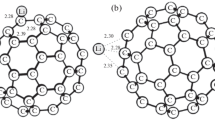Abstract
The potential energy surfaces (PESs) of the model reactions Fe(P)O(NX2) + CH4 → Fe(P)(NX2) + CH3OH (X = H, F, Li) in the isolated state with different multiplicity have been calculated by the density functional theory B3LYP method with the 6-31G and 6-31G* basis sets. The optimized geometric, energetic, and spectroscopic characteristics of the key structures corresponding to local minima and transition states on the PES are determined; the energies and potential barriers of the reactions have been estimated, and their behavior as a function of the gas-phase states multiplicity and the electronegativity of the substituent X in the axial amino group has been studied. For all reactions, the lowest barriers are observed for the closely spaced quartet and doublet terms. The barriers considerably increase when the H atoms in the amino group are replaced by more electronegative atoms (F) and slightly decrease when H is replaced by more electropositive atoms (Li). On the basis of calculations for some structures corresponding to the stationary points on the PES of an analogous reaction of methane oxidation with the binuclear μ-N complex Fe(P)Fe(P)O, it was assumed that the effect of the second porphyrin ring on the upper active site in the binuclear μ-N complex is not too different from the effect of the amino group in the mononuclear complex Fe(P)O(NH2) and that the role of the second ring in the μ-N complex is mainly reduced to the steric protection of the nitrogen atom from the interaction with the oxidant.
Similar content being viewed by others
References
A. A. Shteinman, Usp. Khim. 77(11) (2008).
M. Merkx, D. A. Kopp, M. H. Sazinsky, et al., Angew. Chem., Int. Ed. 40, 2783 (2001).
M. H. Baik, M. Newcomb, R. A. Friesner, and S. J. Lippard, Chem. Rev. 103, 2385 (2003).
E. G. Kovaleva, M. B. Neibergall, S. Chakrabarty, and J. D. Lipscomb, Acc. Chem. Res. 40, 475 (2007).
L. Shu, J. C. Nesheim, K. Kauffmann, et al., Science 275, 515 (1997).
E. Y. Tshuva and S. J. Lippard, Chem. Rev. 104, 987 (2004).
M. Costas, J.-U. Rohde, A. Stubna, et al., J. Am. Chem. Soc. 123, 12931 (2001).
A. B. Sorokin, E. V. Kudrika, and D. Bouchub, J. Chem. Soc., Chem. Commun., 2562 (2008).
P. Mars and D. W. Van Krevelen, Chem. Eng. Sci. Suppl. 3, 3 (1954).
S. Shaik, H. Hirao, and D. Kumar, Acc. Chem. Res. 40, 532 (2007).
S. Shaik, D. Kumar, and S. de Visser, J. Am. Chem. Soc. 130(31), 10128 (2008).
G. Fu, Z.-N. Chen, X. Xu, and H.-L. Wan, J. Phys. Chem. A 112, 717 (2008).
S. Shaik, S. Cohen, S. P. de Visser, et al., Eur. J. Inorg. Chem., 207 (2004).
F. Ogliaro, N. Harris, S. Cohen, et al., J. Am. Chem. Soc. 122, 8977 (2000).
S. Shaik, H. Hirao, and D. Kumar, Nat. Prod. Rep. 24, 533 (2007).
O. P. Charkin, A. V. Makarov, and N. M. Klimenko, Zh. Neorg. Khim. 53, 716 (2008) [Russ. J. Inorg. Chem. 53(5), 718 (2008)].
A. D. Becke, J. Chem. Phys. 98, 5648 (1993).
C. Lee, W. Yang, and R. G. Parr, Phys. Rev. B: Condens. Matter 37, 785 (1988).
J. P. Pewder, Phys. Rev. B: Condens. Matter 33, 8822 (1986).
M. Frish et al., GAUSSIAN 03, Revision B.03 (Gaussian, Inc., Pittsburg, PA, 2003).
Author information
Authors and Affiliations
Corresponding author
Additional information
Original Russian Text © O.P. Charkin, A.V. Makarov, N.M. Klimenko, 2009, published in Zhurnal Neorganicheskoi Khimii, 2009, Vol. 54, No. 9, pp. 1493–1502.
Rights and permissions
About this article
Cite this article
Charkin, O.P., Makarov, A.V. & Klimenko, N.M. Theoretical study of the model reaction of oxidation of methane to methyl alcohol by Fe(P)O(NH2) and related oxoferryl porphyrin complexes (P = C20H12N4). Russ. J. Inorg. Chem. 54, 1424–1432 (2009). https://doi.org/10.1134/S0036023609090149
Received:
Published:
Issue Date:
DOI: https://doi.org/10.1134/S0036023609090149




